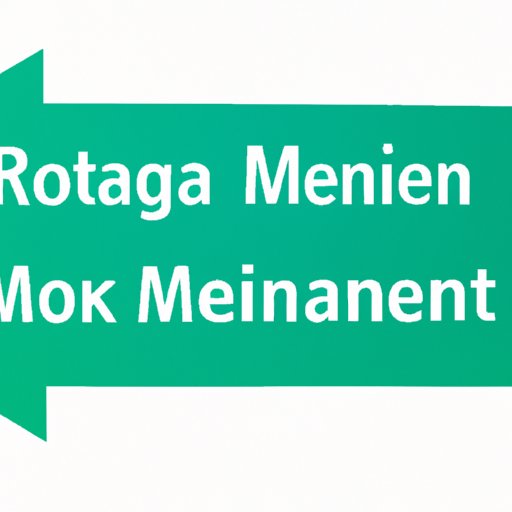Introduction
Returns Management Authorization (RMA) is an essential part of any business that deals with consumer goods. When products don’t meet customer expectations or arrive damaged, RMA allows them to return the product and receive a replacement or refund. However, RMA involves much more than just the act of returning a product. In this article, we’ll explore the basics of RMA and how businesses can make the process more efficient for both themselves and their customers.
A Beginner’s Guide to RMA: Everything You Need to Know
RMA is a process where a customer can return a product to a business, usually due to product defects, damage, or incorrect items sent. RMA is an agreement between the seller and buyer to enable the customer to return the product and receive a refund or replacement. When the customer initiates an RMA, they must provide the reason they want to return the product and proof of purchase. The products eligible for RMA are usually consumer goods such as electronics, clothing, or appliances that arrive defective, damaged, or don’t meet the customer’s expectations.
The process involved in filing an RMA request can vary depending on the company’s policies and procedures. However, in general, the customer will fill out an RMA form, which includes the reason for return and any supporting documentation. Then, the customer will send the product back to the company, usually along with the RMA form, and wait for confirmation of the return. Once confirmed, the company will process the return by either refunding the customer or sending a replacement product.
It’s essential to keep a record of RMA requests for future reference. Maintaining accurate records of RMA requests can help businesses identify patterns in the problems reported and improve their product quality over time.
Why RMA Should Be a Vital Part of Your Business Strategy
The impact of RMA on businesses goes beyond the basic refund or exchange. It can play a vital role in building customer loyalty and retention. By offering hassle-free RMA services, businesses can improve their reputation and show customers they care about their satisfaction. Furthermore, RMA provides crucial insights into areas where the business can improve its products or services, ultimately leading to increased customer satisfaction.
For example, an RMA request may highlight an issue with a particular batch of products. By analyzing this data, businesses can identify and resolve the issue and improve the quality of their products over time. By offering a smooth and efficient RMA process, businesses can demonstrate their commitment to their customers and establish a loyal customer base.
Maximizing Your Returns: Tips and Tricks for Efficient RMA Process
Businesses can take several steps to make the RMA process more efficient. First and foremost, providing clear and concise instructions to customers for filing an RMA request can reduce confusion and unnecessary delays. Additionally, pre-authorizing returns or automatically processing returns for certain products can save time and reduce the number of customer inquiries.
Before sending a product for RMA, businesses should ensure they have all the necessary documentation and follow any specific packaging instructions provided by the company. Providing a prepaid shipping label or covering shipping costs entirely can also streamline the process for customers and increase the chances of a successful return.
The Pros and Cons of RMA for Consumers and Businesses
As with any business process, there are benefits and drawbacks to RMA. Consumers can benefit from RMA in several ways, such as product replacement, refunds, or exchanges. Additionally, offering a hassle-free RMA process can increase customer satisfaction and loyalty. For businesses, RMA can lead to cost savings by reducing returns caused by defective products or incorrectly shipped items. Furthermore, RMA provides valuable insights into product quality control and customer satisfaction, allowing businesses to continuously improve their products and services.
However, potential downsides of RMA include the cost of shipping and potential delays in processing returns. Additionally, some customers may abuse the RMA process by falsely claiming damage or defects in the product.
How to Avoid Common Mistakes During RMA Process
When it comes to RMA, accuracy and attention to detail are essential. Common mistakes can lead to delays and added costs for both businesses and customers. Customers should be careful to provide all necessary documentation, including proof of purchase and reason for return, to avoid any confusion. Furthermore, following any specific packaging instructions provided by the company can reduce the likelihood of damage during shipping. Businesses should also ensure that their customer service team is trained to provide accurate information about the RMA process and that the process is clearly outlined for customers to follow.
The Future of RMA: Trends, and Innovations to Watch Out For
The future of RMA is likely to see increased automation and the use of new technologies. Business owners can expect to see RMA software that automates the RMA process, including pre-authorizations, product tracking, and automated refunds or exchanges. Additionally, new technologies such as AI and machine learning may be used to improve the accuracy and efficiency of RMA processes. Staying up-to-date on these trends and advancements can help businesses streamline and improve their RMA process.
Conclusion
RMA is an essential process for any business handling consumer goods. Providing a hassle-free RMA experience can build customer loyalty and provide valuable insights into areas where the business can improve its product quality and services. By following best practices and avoiding common mistakes during the RMA process, businesses and customers alike can benefit from the efficiency and accuracy of the process. As RMA technologies and innovations continue to evolve, businesses that stay up-to-date and implement new strategies will gain a competitive edge in the industry.
